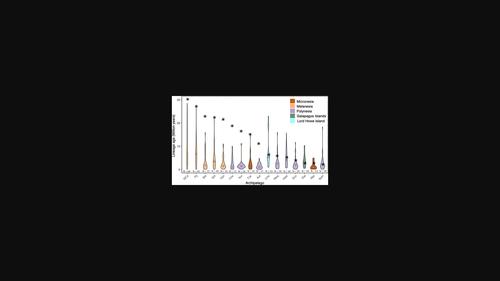Slowing taxon cycle can explain biodiversity patterns on islands: Insights into the biogeography of the tropical South Pacific from molecular data
IF 3.7
引用次数: 0
Abstract
Abstract Islands in the tropical Pacific Ocean are renowned for high biodiversity and endemism despite having relatively small landmasses. However, our knowledge of how this biodiversity is formed remains limited. The taxon cycle, where well‐dispersed, earlier colonizers become displaced from coastal to inland habitats by new waves of colonizers, producing isolated, range‐restricted species, has been proposed to explain current biodiversity patterns. Here, we integrate the outcomes of phylogenetic studies in the region to investigate the sources, age, number of colonizations, and diversification of 16 archipelagos in the tropical and subtropical South Pacific. We then evaluate whether the results support the taxon cycle as a plausible mechanism for these observations. We find that most species in the Pacific arrived less than 5 Mya from geographically close sources, suggesting that colonization by new taxa is a frequent and ongoing process. Therefore, our findings are broadly consistent with the theory of the Taxon Cycle, which posits that ongoing colonization results in the gradual displacement of established lineages. Only the oldest archipelagos, New Caledonia and Fiji, do not conform to this trend, having proportionally less recent colonization events, suggesting that the taxon cycle may slow on older islands. This conclusion is further validated by New Caledonia having lower diversification rate estimates than younger islands. We found that diversification rates across archipelagos are negatively correlated with area and age. Therefore, a taxon cycle that slows with island age appears to be a suitable concept for understanding the dynamic nature and biodiversity patterns of the Pacific Islands.

减缓分类单元周期可以解释岛屿上的生物多样性模式:从分子数据对热带南太平洋生物地理学的见解
热带太平洋上的岛屿以其高生物多样性和地方性而闻名,尽管它们的陆地面积相对较小。然而,我们对这种生物多样性是如何形成的了解仍然有限。在分类单元循环中,分散良好的早期殖民者被新一波殖民者从沿海栖息地迁移到内陆栖息地,产生了孤立的、范围受限的物种,这被用来解释当前的生物多样性模式。在这里,我们整合了该地区系统发育研究的结果,调查了热带和亚热带南太平洋16个群岛的来源、年龄、殖民地数量和多样性。然后,我们评估结果是否支持分类群循环作为这些观察的合理机制。我们发现太平洋上的大多数物种都是在5亿年前从地理上接近的来源到达的,这表明新分类群的殖民化是一个频繁和持续的过程。因此,我们的发现与分类单元循环理论大致一致,该理论认为持续的殖民化导致已建立的谱系逐渐被取代。只有最古老的群岛,新喀里多尼亚群岛和斐济群岛,不符合这一趋势,它们最近的殖民事件相对较少,这表明在较古老的岛屿上,分类单元周期可能会放缓。新喀里多尼亚的多样化率估计比较年轻的岛屿要低,这进一步证实了这一结论。我们发现,群岛的多样化率与面积和年龄呈负相关。因此,随着岛屿年龄的增长而减慢的分类单元周期似乎是理解太平洋岛屿动态性质和生物多样性模式的合适概念。
本文章由计算机程序翻译,如有差异,请以英文原文为准。
求助全文
约1分钟内获得全文
求助全文

 求助内容:
求助内容: 应助结果提醒方式:
应助结果提醒方式:


